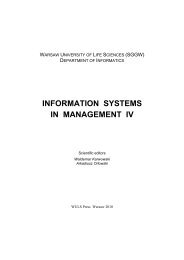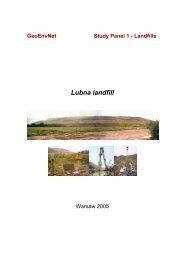66 L. Mazal, K.J. RowlesTable 4. Acceptance of the null hypothesis at the 1% significance levelTabela 4. Przyjęcie hipotezy zerowej na poziomie istotności 1%GDPIndex of Industrial Production5% 1% 5% 1%The Czech Republic Accepted Accepted Accepted AcceptedSlovakia Accepted Accepted Accepted AcceptedPoland Accepted Accepted Accepted AcceptedHungary Accepted Accepted Accepted AcceptedSource: Authors’ calculations.Źródło: Obliczenia własne.In order to test residual autocorrelation Enders [2004, p. 188] used the Durin-Watsonstatistic [Durbin and Watson 1951]. However, Nerlove and Wallis [1966] points out thatif lagged dependent variables are included in an equation estimated by ordinary leastsquares method “the value of Durbin-Watson statistic is asymptotically biased towards2”, which means towards indicating no autocorrelation. Durbin [1970] confirms thesefindings. Greene [2002] suggests using the Ljung-Box Q test [Ljung and Box 1978] incase of regression equation with lagged dependent variables. Thus, the Durbin-Watsonstatistic [Durbin and Watson 1951] can be used in case of Polish GDP only, where it hasvalue of 2.157, which indicates no residual autocorrelation.The column labelled as Q in tables 2 and 3 provides the values of the Ljung-Box statisticat lag 10. The critical value of the χ 2 1–0.05 distribution based on the correspondingdegrees of freedom is 30.5779 at the 1% significance level. It is apparent that there is nosignificant residual autocorrelation in six of eight cases; only in the case of Czech and Slovakindustrial production does the Ljung-Box statistic indicate residual autocorrelation.It can be concluded that the outputs and industrial productions of the Central EuropeanCountries contain a unit root. These economic variables should be regarded as differencestationary rather than trend stationary. Further investigation is required to test thevalidity of these findings before conclusive confirmation of the validity of the Keynesianapproach to economic management can be made. Such an investigation will be the subjectof further research.CONCLUSIONSThe GDP statistics and indices of industrial production of four Central Europeancountries have been examined in order to find out if their outputs are stable around adeterministic trend or if they are stochastic.The Dickey-Fuller test indicates unit root in case of all four countries for both theGDP and the index of industrial production. Difference stationarity means that there is nodeterministic long-run time trend in either GDP series or index of industrial productionseries. These series have a growing tendency, which can be completely overtaken by theinfluence of cyclical fluctuations because these fluctuations have a unit root. Since unitroot implies permanent character, long lasting deviations from this growing tendency areActa Sci. Pol.
Economic Policy in Central Eastern Europe: Unit Root Consequences 67likely. These deviations in fact represent long and deep recessions and confirm Keynes’‘inherent instability of the economy’. In other words, permanent recessions are not onlypossible but also even very likely. Thus, state interventions in Central Eastern Europe toboost economy during these recessions can be regarded as justified. The results are in linewith the Nelson and Posser’s study from 1982. The Dickey-Fuller test also indicates unitroot in case of industrial productions of all four countries.REFERENCESAllsop C., Hayes D.G., 1985. Demand Management Theory and Mangement. The Economic Systemin the UK, Oxford. Oxford University Press.Artis M.J., 1972. Fiscal Policy for Stabilisation. [in:] Beckerman (edit.) The Labour Governments’Economic Record 1964–1970. Duckworth Publishers.Andreou E. and Spanos A., 2003. ‘Statistical Adequacy and the Testing of Trend Versus DifferenceStationarity’. Econometric Reviews, 22, 217–237.Chatfield Ch., 2004. The analysis of time series: an introduction, London, Chapman & Hall/CRC.Corry B., 1983. ‘Keynes and the Theory of Output and Employment part II’. Economic Review,1, 36–39.Cripps F., Godley W. and Fetherston M., 1974. Public Expenditure and the Mangement of theEconomy in Public Expenditure, Inflation and the Balance of Payment. Nineth Report ofthe Expenditure Committee of the House of Lords, HC 328: London H.M.S.O.Dickey D. and Fuller W.A., 1979. ‘Distribution of the Estimators for Autoregressive Time SeriesWith a Unit Root’. Journal of the American Statistical Association, 74, 427–431.Dickey D. and Fuller W. A., 1981. ‘Likelihood Ratio Statistics for Autoregressive Time Series witha Unit Root‘. Econometrica, 49, 1057–1072.Durbin J., Watson, G. S., 1951. ‘Testing for Serial Correlation in Least Squares Regression. II.Biometrika, 38, 159–177.Durbin J., 1970. ‘Testing for Serial Correlation in Least-Squares Regression When Some of theRegressors are Lagged Dependent Variables’. Econometrica, 38, 410–421.Enders W., 2004. Applied econometric time series, Hoboken, John Wiley & Sons.Flessig A.R., and Strauss J., 1999. ‘Is OECD Real Per Capita GDP Trend or Difference Stationary?Evidence from Panel Unit Root Tests’. Journal of Macroeconomics, 21, 673–690.Greene W.H., 2002. Econometric analysis 5th ed. New Presley, Upper Saddle River.Hansen B., 1969. Fiscal Policy in Seven Countries 1955–1965. Paris, O.E.C.D.Keynes J. M., 1926. The End of Laissez-Faire in The Economic Consequences of the Peace. London,Hogarth.Keynes J. M., 1936. The General Theory of Employment Interest and Money, London. Macmillanand Co Ltd.Li X. M., 2000. ‘The Great Leap Forward, Economic Reforms, and the Unit Root Hypothesis:Testing for Breaking Trend Functions in China’s GDP Data’. Journal of ComparativeEconomics, 28, 814–827.Ljung M., Box, G.E.P., 1978. ‘On a Measure of Lack of Fit in Time Series Models’. Biometrika,65, 297–303.Lucas R.E. Jr., 1972. ‘Expectations and the Neutrality of Money’. Journal of Economic Theory, 4,103–124.Muth J.F., 1961. ‘Rational Expectations and the Theory of Price Movements‘. Econometrica, 29,315–335.Narayan P.K., 2006. ‘Are G7 per capita real GDP levels non stationary, 1870–2001?’. Japan and theWorld Economy, 19, 374–379.Oeconomia 10 (1) 2011
- Page 6 and 7:
6 A. Gawrońska, S. Paszkowskicultu
- Page 8 and 9:
8 A. Gawrońska, S. Paszkowskinumbe
- Page 10 and 11:
10 A. Gawrońska, S. PaszkowskiTabl
- Page 12:
12 A. Gawrońska, S. PaszkowskiTabl
- Page 15 and 16: The distribution of social security
- Page 17 and 18: %180,0160,0140,0120,0100,080,060,04
- Page 19: The distribution of social security
- Page 22 and 23: 22 R. Hryniewski, W. Mądry, D. Goz
- Page 24 and 25: 24 R. Hryniewski, W. Mądry, D. Goz
- Page 26 and 27: 26 R. Hryniewski, W. Mądry, D. Goz
- Page 28 and 29: 28 R. Hryniewski, W. Mądry, D. Goz
- Page 30 and 31: 30 R. Hryniewski, W. Mądry, D. Goz
- Page 32 and 33: 32 R. Hryniewski, W. Mądry, D. Goz
- Page 35 and 36: Oeconomia 10 (1) 2011, 35-43EDUCATI
- Page 37 and 38: Education as an element of competit
- Page 39 and 40: Education as an element of competit
- Page 41 and 42: Education as an element of competit
- Page 43: Education as an element of competit
- Page 46 and 47: 46 E. Majewski, P. Sulewski, M. Rag
- Page 48 and 49: 48 E. Majewski, P. Sulewski, M. Rag
- Page 50 and 51: 50 E. Majewski, P. Sulewski, M. Rag
- Page 52 and 53: 52 E. Majewski, P. Sulewski, M. Rag
- Page 54 and 55: 54 E. Majewski, P. Sulewski, M. Rag
- Page 56 and 57: 56 E. Majewski, P. Sulewski, M. Rag
- Page 58 and 59: 58 L. Mazal, K.J. RowlesIn the West
- Page 60 and 61: 60 L. Mazal, K.J. RowlesThe most im
- Page 62 and 63: 62 L. Mazal, K.J. RowlesGDPt= GDP0+
- Page 64 and 65: 64 L. Mazal, K.J. RowlesTHE TIME SE
- Page 68 and 69: 68 L. Mazal, K.J. RowlesNelson Ch.R
- Page 70 and 71: 70 A. Ptak-Chmielewskastatistics, w
- Page 72 and 73: 72 A. Ptak-Chmielewska3025birth rat
- Page 74 and 75: 74 A. Ptak-ChmielewskaSECTOR OF ACT
- Page 76 and 77: 76 A. Ptak-Chmielewskabirth rate fo
- Page 78 and 79: 78 A. Ptak-Chmielewskawere trade fi
- Page 80 and 81: 80 A. Ptak-ChmielewskaREFERENCESBal
- Page 83 and 84: Oeconomia 10 (1) 2011, 83-95THE EFF
- Page 85 and 86: The effi ciency of selected real es
- Page 87 and 88: The effi ciency of selected real es
- Page 89 and 90: Table 1. Efficiency of real estate
- Page 91 and 92: The effi ciency of selected real es
- Page 93 and 94: The effi ciency of selected real es
- Page 95: The effi ciency of selected real es
- Page 98 and 99: 98 J. Sosnowski, G.A. CiepielaJalin
- Page 100 and 101: 100 J. Sosnowski, G.A. Ciepiela2007
- Page 102 and 103: 102 J. Sosnowski, G.A. CiepielaTabl
- Page 104 and 105: 104 J. Sosnowski, G.A. CiepielaTabl
- Page 106 and 107: 106 J. Sosnowski, G.A. Ciepiela1400
- Page 108 and 109: 108 J. Sosnowski, G.A. CiepielaOsek
- Page 110 and 111: 110 E. SzymańskaProducts by Activi
- Page 112 and 113: 112 E. Szymańskatroduced TFI which
- Page 114 and 115: 114 E. Szymańskabers of companies
- Page 116 and 117:
116 E. SzymańskaTable 3. Tourism v
- Page 118 and 119:
118 E. SzymańskaREFERENCESCoccossi
- Page 120 and 121:
120 J. WiśniewskaEvery society can
- Page 122 and 123:
122 J. WiśniewskaStatistical analy
- Page 124 and 125:
124 J. WiśniewskaCommon Agricultur
- Page 126 and 127:
126 J. WiśniewskaTable 3. An attem
- Page 128 and 129:
128 J. Wiśniewskathe application o
- Page 130 and 131:
130 J. Wiśniewskainstitutional cos
- Page 132 and 133:
132 J. Wiśniewskaemployed in agric
- Page 134 and 135:
134 J. WiśniewskaLong term viabili
- Page 136 and 137:
136 J. Wiśniewska--The level of re
- Page 139 and 140:
Oeconomia 10 (1) 2011, 139-148INNOV
- Page 141 and 142:
Innovativeness of food production e
- Page 143 and 144:
Innovativeness of food production e
- Page 145 and 146:
Innovativeness of food production e
- Page 147 and 148:
Innovativeness of food production e
- Page 149 and 150:
Oeconomia 10 (1) 2011, 149-158LOCAL
- Page 151 and 152:
Local governance activities in supp
- Page 153 and 154:
Local governance activities in supp
- Page 155 and 156:
Local governance activities in supp
- Page 157 and 158:
Local governance activities in supp
- Page 159 and 160:
Oeconomia 10 (1) 2011, 159-169CHANG
- Page 161 and 162:
Changes in rural women’s movement
- Page 163 and 164:
Changes in rural women’s movement
- Page 165 and 166:
Changes in rural women’s movement
- Page 167 and 168:
Changes in rural women’s movement
- Page 169:
Changes in rural women’s movement
- Page 172:
Ewa SzymańskaTourism function of M
















